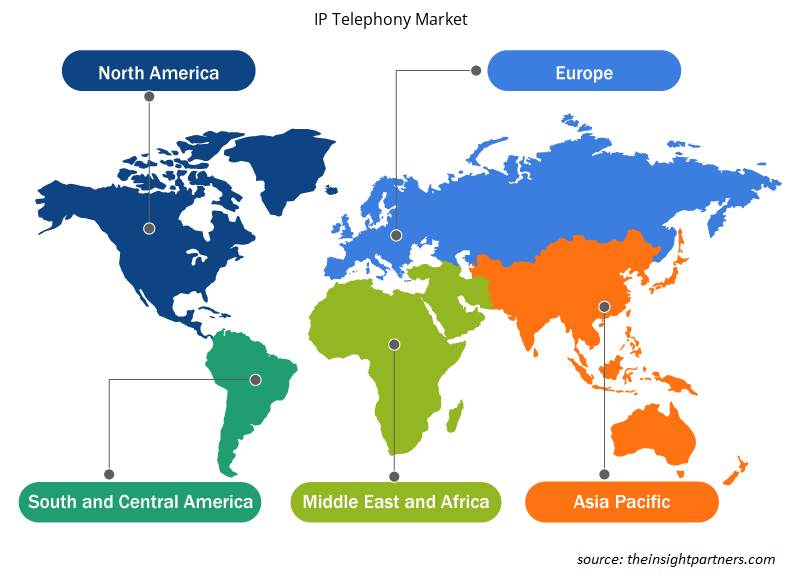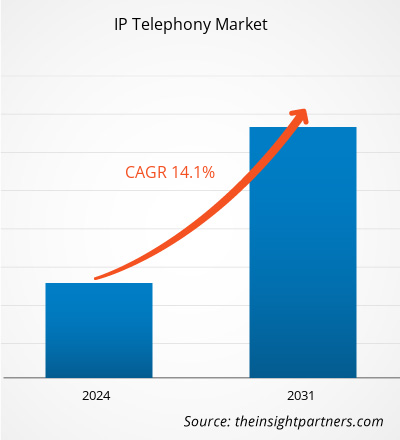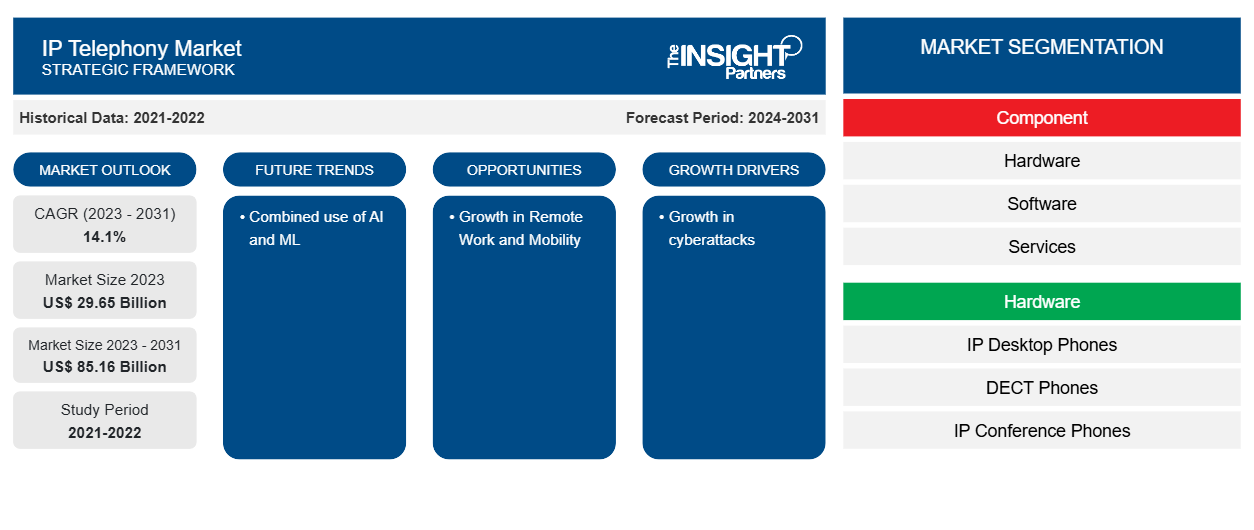من المتوقع أن يصل حجم سوق الهاتف عبر بروتوكول الإنترنت إلى 85.16 مليار دولار أمريكي بحلول عام 2031 من 29.65 مليار دولار أمريكي في عام 2023. ومن المتوقع أن يسجل سوق الهاتف عبر بروتوكول الإنترنت معدل نمو سنوي مركب بنسبة 14.1٪ خلال الفترة 2023-2031. يعد نقل الصوت عبر بروتوكول الإنترنت (VoIP) خدمة وتطبيقًا يندرج تحت مظلة الهاتف عبر بروتوكول الإنترنت. إنه نقل الاتصالات الصوتية عبر شبكات بروتوكول الإنترنت.
تحليل سوق الهاتف عبر بروتوكول الإنترنت
يقدم بروتوكول الإنترنت (IP) مجموعة متنوعة من الخدمات، مثل الاتصال الصوتي، ومكالمات الفيديو، والبريد الصوتي، والفاكس، والمراسلة الفورية (1M)، ومؤتمرات الفيديو. على عكس VolP، غالبًا ما يقدم بروتوكول الإنترنت أكثر من مجرد وظائف صوتية. يستفيد من بروتوكول الإنترنت المؤسسات من جميع الأحجام من خلال توفير شبكة مشتركة لميزات الهاتف والإنترنت. يوفر بروتوكول الإنترنت تكاليف أقل وبنية أساسية أبسط وقابلية للتطوير والتنقل، مما يجعله جذابًا للمستخدمين النهائيين.
نظرة عامة على سوق الهاتف عبر بروتوكول الإنترنت
يشير مصطلح الهاتف عبر بروتوكول الإنترنت إلى أي نظام يقع ضمن الاتصالات القائمة على الإنترنت، بما في ذلك الفاكس والتقنيات الأخرى. ويستخدم مجموعة متنوعة من بروتوكولات المصدر المفتوح لإرسال البيانات من الهاتف إلى مزود الخدمة. وتطبق الشركات بسرعة حلول الهاتف عبر بروتوكول الإنترنت نظرًا لسهولة نقلها وفعاليتها من حيث التكلفة. وعلاوة على ذلك، فإن أنظمة الهاتف عبر بروتوكول الإنترنت سهلة الاستخدام وتوفر تقنيات متقدمة وتعزز الإنتاجية. وهذه العوامل تدفع إلى تبني أنظمة الهاتف عبر بروتوكول الإنترنت. ويضيف الهاتف عبر بروتوكول الإنترنت ميزة جديدة إلى هواتف الأعمال ويحسن الاتصال من خلال تقديم حل فعال من حيث التكلفة، وهو ما يُعتبر محركًا رئيسيًا لسوق الهاتف عبر بروتوكول الإنترنت في جميع أنحاء العالم. ويمكن بسهولة ربط الأنظمة والأجهزة القديمة الحالية، مثل أجهزة الفاكس وقارئات بطاقات الائتمان وأجهزة الإنذار، بأنظمة الهاتف عبر بروتوكول الإنترنت.
قم بتخصيص هذا التقرير ليناسب متطلباتك
ستحصل على تخصيص لأي تقرير - مجانًا - بما في ذلك أجزاء من هذا التقرير، أو تحليل على مستوى الدولة، وحزمة بيانات Excel، بالإضافة إلى الاستفادة من العروض والخصومات الرائعة للشركات الناشئة والجامعات
- احصل على أهم اتجاهات السوق الرئيسية لهذا التقرير.ستتضمن هذه العينة المجانية تحليلاً للبيانات، بدءًا من اتجاهات السوق وحتى التقديرات والتوقعات.
محركات وفرص سوق الهاتف عبر بروتوكول الإنترنت
تزايد الهجمات الإلكترونية لصالح السوق
لقد أدت التطورات التكنولوجية السريعة إلى زيادة نقاط الضعف في السنوات الأخيرة. تعتمد الشركات بشكل متزايد على منتجات وخدمات الهاتف عبر بروتوكول الإنترنت مع شيوع الهجمات الإلكترونية. تقدر شركة IBM أن التكلفة الإجمالية لاختراقات البيانات في الشركات ستبلغ حوالي 6 تريليون دولار أمريكي في عام 2021 وحده. ومن المتوقع أن ترتفع الأرقام خلال الإطار الزمني المتوقع. وبالتالي، تقوم الشركات بنشر حلول الهاتف عبر بروتوكول الإنترنت لحماية البيانات ومنع الاختراقات، ومن المتوقع أن يعزز هذا من معدل النمو السنوي المركب لسوق الهاتف عبر بروتوكول الإنترنت طوال فترة التنبؤ.
ارتفاع ثقافة العمل عن بعد
إن الاستخدام المتزايد للأجهزة المحمولة والاعتماد المتزايد على ثقافة العمل عن بعد يدفعان الطلب على حلول الهاتف عبر بروتوكول الإنترنت القابلة للتكيف والمتاحة بسرعة. ويستخدم الموظفون بشكل متزايد تطبيقات الهواتف الذكية لإجراء واستقبال المكالمات من أي مكان. وعلاوة على ذلك، يتطلب التعاون عن بعد التواصل باستخدام برامج مؤتمرات الفيديو. ويركز مزودو الهاتف عبر بروتوكول الإنترنت على تطوير حلول تعالج هذه الاحتياجات المتطورة.
تقرير تحليل تجزئة سوق الهاتف عبر بروتوكول الإنترنت
إن القطاعات الرئيسية التي ساهمت في اشتقاق تحليل سوق الهاتف عبر بروتوكول الإنترنت هي المكونات والأجهزة والخدمة ونوع التثبيت ونوع المؤسسة والمستخدمين النهائيين.
- وفقًا للمكون، يتم تقسيم سوق الهاتف عبر بروتوكول الإنترنت إلى أجهزة وبرامج وخدمات.
- بحسب الأجهزة، يتم تقسيم السوق إلى هواتف سطح المكتب IP، وهواتف DECT، وهواتف المؤتمرات IP.
- بناءً على الخدمة، يتم تقسيم سوق الهاتف عبر بروتوكول الإنترنت إلى خدمات التثبيت والصيانة والخدمات المهنية.
- اعتمادًا على نوع التثبيت، يتم تقسيم سوق الهاتف عبر IP إلى سلكي ولاسلكي.
- اعتمادًا على حجم المؤسسة، يتم تقسيم سوق الهاتف عبر بروتوكول الإنترنت إلى الشركات الصغيرة والمتوسطة والمؤسسات الكبيرة.
- وفقًا للمستخدمين النهائيين، يتم تقسيم سوق الهاتف عبر بروتوكول الإنترنت إلى مؤسسات سكنية وشركاتية وحكومية.
تحليل حصة سوق الهاتف عبر بروتوكول الإنترنت حسب المنطقة الجغرافية
ينقسممم النطاق الجغرافي لتقرير سوق الهاتف عبر بروتوكول الإنترنت بشكل أساسي إلى خمس مناطق: أمريكا الشمالية، ومنطقة آسيا والمحيط الهادئ، وأوروبا، والشرق الأوسط وأفريقيا، وأمريكا الجنوبية والوسطى. تنبع الأسباب المعنية من الزيادات العالمية في تبني تطبيقات الهاتف عبر بروتوكول الإنترنت والتقدم التكنولوجي. غالبًا ما يتم إنشاء هذه التطبيقات في قطاعات صناعية معينة، مثل BFSI، والرعاية الصحية، وتجارة التجزئة، وتكنولوجيا المعلومات، والاتصالات. علاوة على ذلك، من المتوقع أن يكون نمو المنطقة مدفوعًا بالاستخدام الواسع النطاق لخدمات الهاتف عبر بروتوكول الإنترنت، والبنية الأساسية للاتصالات المتطورة، وجاذبية تنقل العمالة.
رؤى إقليمية حول سوق الهاتف عبر بروتوكول الإنترنت
لقد قام المحللون في Insight Partners بشرح الاتجاهات والعوامل الإقليمية المؤثرة على سوق الهاتف عبر بروتوكول الإنترنت طوال فترة التوقعات بشكل شامل. يناقش هذا القسم أيضًا قطاعات سوق الهاتف عبر بروتوكول الإنترنت والجغرافيا في جميع أنحاء أمريكا الشمالية وأوروبا ومنطقة آسيا والمحيط الهادئ والشرق الأوسط وأفريقيا وأمريكا الجنوبية والوسطى.

- احصل على البيانات الإقليمية المحددة لسوق الهاتف عبر بروتوكول الإنترنت
نطاق تقرير سوق الهاتف عبر بروتوكول الإنترنت
| سمة التقرير | تفاصيل |
|---|---|
| حجم السوق في عام 2023 | 29.65 مليار دولار أمريكي |
| حجم السوق بحلول عام 2031 | 85.16 مليار دولار أمريكي |
| معدل النمو السنوي المركب العالمي (2023 - 2031) | 14.1% |
| البيانات التاريخية | 2021-2022 |
| فترة التنبؤ | 2024-2031 |
| القطاعات المغطاة | حسب المكون
|
| المناطق والدول المغطاة | أمريكا الشمالية
|
| قادة السوق وملفات تعريف الشركات الرئيسية |
|
كثافة اللاعبين في سوق الهاتف عبر بروتوكول الإنترنت: فهم تأثيرها على ديناميكيات الأعمال
يشهد سوق الهاتف عبر بروتوكول الإنترنت نموًا سريعًا، مدفوعًا بالطلب المتزايد من جانب المستخدم النهائي بسبب عوامل مثل تفضيلات المستهلكين المتطورة والتقدم التكنولوجي والوعي المتزايد بفوائد المنتج. ومع ارتفاع الطلب، تعمل الشركات على توسيع عروضها والابتكار لتلبية احتياجات المستهلكين والاستفادة من الاتجاهات الناشئة، مما يؤدي إلى زيادة نمو السوق.
تشير كثافة اللاعبين في السوق إلى توزيع الشركات أو المؤسسات العاملة في سوق أو صناعة معينة. وهي تشير إلى عدد المنافسين (اللاعبين في السوق) الموجودين في مساحة سوق معينة نسبة إلى حجمها أو قيمتها السوقية الإجمالية.
الشركات الرئيسية العاملة في سوق الهاتف عبر بروتوكول الإنترنت هي:
- شركة أفايا
- شركة سيسكو سيستمز
- جيجاسيت للاتصالات
- شركة إل جي إلكترونيكس المحدودة
- شركة ميتيل نتوركس
- شركة باناسونيك
إخلاء المسؤولية : الشركات المذكورة أعلاه ليست مرتبة بأي ترتيب معين.

- احصل على نظرة عامة على أهم اللاعبين الرئيسيين في سوق الهاتف عبر بروتوكول الإنترنت
أخبار سوق الهاتف عبر بروتوكول الإنترنت والتطورات الأخيرة
يتم تقييم سوق الهاتف عبر بروتوكول الإنترنت من خلال جمع البيانات النوعية والكمية بعد البحث الأولي والثانوي، والتي تتضمن منشورات الشركات المهمة وبيانات الجمعيات وقواعد البيانات. فيما يلي بعض التطورات في سوق الهاتف عبر بروتوكول الإنترنت:
- فازت شركة Broadvoice - وهي شركة تقدم خدمات الصوت المستضاف والاتصالات الموحدة وخطوط SIP - بجائزة أفضل منتج للاتصالات الهاتفية عبر الإنترنت لعام 2022. وعلى مدار السنوات الثلاث والعشرين الماضية، كرمت الجائزة منتجات وخدمات الاتصالات عبر بروتوكول الإنترنت (VoIP) وبروتوكول الإنترنت (IP).
(المصدر: Broadvoice، بيان صحفي، مارس 2022)
- توفر Pure IP اتصالات صوتية عالمية للمؤسسات. ويمكن الوصول إليها الآن عبر نظام Zoom Phone Provider Exchange. وسيتمتع العملاء بحرية أكبر مع هذا البرنامج. وسيحافظ على Pure IP أثناء استخدام شبكة الاتصالات الخاصة به في أماكن أخرى.
(المصدر: Pure IP، بيان صحفي، أبريل 2023)
تقرير سوق الهاتف عبر بروتوكول الإنترنت: التغطية والنتائج المتوقعة
يوفر تقرير "حجم سوق الهاتف عبر بروتوكول الإنترنت والتوقعات (2021-2031)" تحليلاً مفصلاً للسوق يغطي المجالات التالية:
- حجم سوق الهاتف عبر بروتوكول الإنترنت وتوقعاته على المستويات العالمية والإقليمية والوطنية لجميع قطاعات السوق الرئيسية التي يغطيها النطاق
- اتجاهات سوق الهاتف عبر بروتوكول الإنترنت بالإضافة إلى ديناميكيات السوق مثل المحركات والقيود والفرص الرئيسية
- تحليل مفصل لقوى PEST/Porter الخمس وSWOT
- تحليل سوق الهاتف عبر بروتوكول الإنترنت يغطي اتجاهات السوق الرئيسية والإطار العالمي والإقليمي والجهات الفاعلة الرئيسية واللوائح والتطورات الأخيرة في السوق
- تحليل المشهد الصناعي والمنافسة الذي يغطي تركيز السوق، وتحليل خريطة الحرارة، واللاعبين البارزين، والتطورات الأخيرة لسوق الهاتف عبر بروتوكول الإنترنت
- ملفات تعريف الشركة التفصيلية
- التحليل التاريخي (سنتان)، سنة الأساس، التوقعات (7 سنوات) مع معدل النمو السنوي المركب
- تحليل PEST و SWOT
- حجم السوق والقيمة / الحجم - عالمي، إقليمي، بلد
- الصناعة والمنافسة
- مجموعة بيانات إكسل
التقارير الحديثة
شهادات العملاء
سبب الشراء
- اتخاذ قرارات مدروسة
- فهم ديناميكيات السوق
- تحليل المنافسة
- رؤى العملاء
- توقعات السوق
- تخفيف المخاطر
- التخطيط الاستراتيجي
- مبررات الاستثمار
- تحديد الأسواق الناشئة
- تحسين استراتيجيات التسويق
- تعزيز الكفاءة التشغيلية
- مواكبة التوجهات التنظيمية























 احصل على عينة مجانية ل - سوق الهاتف عبر بروتوكول الإنترنت
احصل على عينة مجانية ل - سوق الهاتف عبر بروتوكول الإنترنت